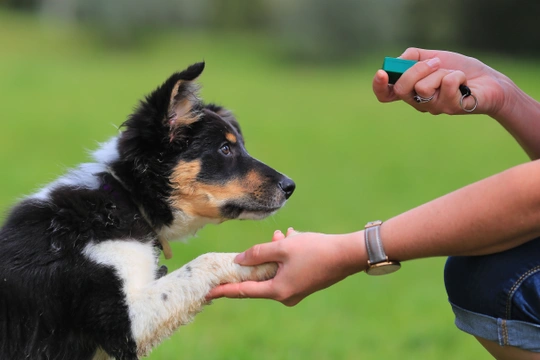
What is clicker training?
Clicker training is one way of teaching your dog using what’s commonly known as ‘positive’ or ‘reward-based’ training. This is where the trainer focuses on what an animal is getting right and rewards them, rather than punishing them for getting something wrong.
When training, it’s not always easy to explain to your dog exactly what they did that earned them the reward. For example, you might want to reward your puppy with a treat for sitting. But, as soon as you move to present the treat it’s likely they will already have stood up again. You can see why it might take the puppy a little time to work out it was their ‘bottom on the ground’ action that was being rewarded, and not the jumping at your legs that followed it!
That’s why many trainers use a ‘marker’, usually an easily replicable and unique sound, to tell the puppy exactly which action earned the reward. A puppy will soon learn that every time they hear a particular sound a treat will follow, and this can make it easier to be precise about the behaviour you are rewarding.
So, in our ‘sit’ example above, the process would be asking or luring your puppy to sit, and as soon as their bottom touches the ground in a sit, ‘marking’ and then rewarding.
Types of markers used vary. For example, some dog trainers use a word such as ‘yes’ to mark a behaviour; whistles or hand signals can also be used as a marker. However, when some dog trainers found a small metal ‘clicking’ toy and began using it as a marker, it quickly caught on as it so perfectly fitted the bill. It makes a distinctive sound, is easy to use and carry around, is very cheap and, unlike your tone of voice, always sounds the same.
It’s important to remember that the marker is just telling your dog a reward is coming. So, every time you ‘mark’, whatever type you use, you must follow it with a reward (most often food).
Training can be quicker with a clicker
If you decide to try clicker training, it’s a good idea to practise your timing before you teach the dog. It’s a simple device but as with all mechanical skills, the more you practise, the slicker you will become. And the better your timing, the clearer it will be to your dog what action is being rewarded. The clearer it is to your dog, the quicker they will learn!
There are many ways to practise. For example, ask a friend to randomly raise one hand or two and only click when it’s two hands, or bounce a ball and click when the ball hits the ground.
Next, introduce your dog to the clicker. You’ll need your clicker and a number of treats in a treat bag or pot. To begin, just click and immediately give your dog a treat. You can either give it to your dog from your hand or drop it on the ground. At this stage your dog doesn’t need to do anything to earn it – you want them to learn that when they hear the clicker a treat will follow. Repeat a number of times until your dog reacts to the click by looking expectantly for a treat! Many trainers refer to this process as ‘charging the clicker’.
Don’t be concerned that you’ll always have to have a clicker with you. If you’ve forgotten your clicker, you could use a verbal marker instead. And, once you’ve taught your dog something new, you don’t need to use a marker at all (although praise and the occasional reward will certainly help maintain the behaviour).
You can use clicker training for all the things you want to teach your dog, from life skills such as walking on a loose lead or going to their bed, to a variety of tricks.
Clicker training is used all over the world, and not just for training dogs. It’s fun, kind and effective and will help you build a relationship with your dog based on trust and confidence.
So, you see, there’s no magic in the clicker itself – you create the training magic by learning how to teach your dog (or cat or any animal).
For more training advice, please visit our dog coach Vicky Carne's website.



